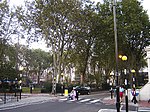Dalston Synagogue

The Dalston Synagogue (also known as the Poets Road Synagogue) was a Jewish place of worship in the London Borough of Islington, North London, from about 1885 to 1970. Jews fleeing the pogroms of the Russian Empire, and those beginning to leave the East End of London and move northwards towards Stoke Newington and Stamford Hill established a congregation in the neighbourhood by 1876. The Victorian Gothic building was erected in Poets Road in 1885, a street just outside the boundaries of Dalston, and became one of the leading members of the United Synagogues.Jacob Koussevitzsky, a member of the famous Koussevitzky cantorial family, was its cantor from 1936, though another source says the 1950s.At its height, the Poets Road Synagogue had hundreds of worshippers; it closed in the late 1960s, as the remaining Jewish population moved further afield. The synagogue site was eventually sold and the building, along with its stained glass windows, was demolished in 1970 and replaced by a block of council flats, leaving no trace of the Jewish life which existed in this area.
Excerpt from the Wikipedia article Dalston Synagogue (License: CC BY-SA 3.0, Authors, Images).Dalston Synagogue
Poet's Road, London Canonbury (London Borough of Islington)
Geographical coordinates (GPS) Address Nearby Places Show on map
Geographical coordinates (GPS)
| Latitude | Longitude |
|---|---|
| N 51.5517 ° | E -0.0867 ° |
Address
Poet's Road
Poet's Road
N5 2SB London, Canonbury (London Borough of Islington)
England, United Kingdom
Open on Google Maps







